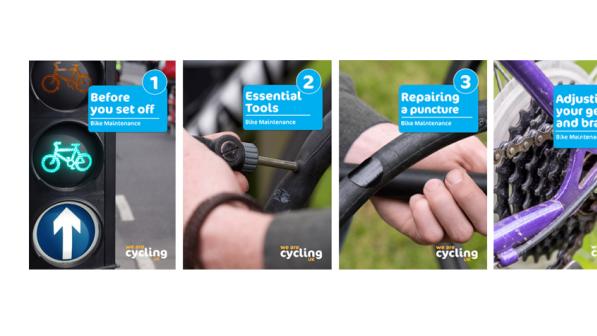A beginners’ guide to … cleaning your bike

I don’t know anyone who likes washing their bike, and apart from my brother, I don’t know anyone who washes it frequently enough. But there are many good reasons to keep your bike clean – and not just because it looks nicer.
It also doesn’t take that long and isn’t as labour intensive as you might think, especially if you do it regularly. Here I go through why and how often you should clean your bike and give some simple steps to getting it clean.
Why clean your bike
Cycles are made from a lot of moving parts that attract dust and dirt. Mud gets stuck between them. This all rubs on those parts and will damage them. This is especially true of the drivetrain. This is the name given to the parts that ‘drive’ the wheels.
The drivetrain consists of the chain, pedals and cranks, chain rings, cassette and derailleurs. It’s powered by the ‘engine’ of your legs. If it ceases to up because of filth and rust then your cycle simply won’t go. Keeping it clean makes your ride smoother and more pleasant.
Cleaning your bike will prolong its life and that of its components, ultimately saving you money.
How often should you clean your bike?
This depends on how often you ride, as well as what and where you ride. If you’re a road rider, aim for every 160km cycled, and more frequently in winter when rain will wash filth onto the roads. If you’re a very occasional rider, then once a month will do it.
Off-road and gravel riders will need to clean their bikes more often. Try to aim for every couple of weeks and after every particularly muddy ride. Consider terrain as well. Sand is particularly damaging so if you ride through sandy terrain a lot, wash it more often.
Seven simple steps to a clean and happy bike
1. Preparation
First, you’re likely to get messy so don’t wear your favourite jeans. Gather together your equipment. There isn’t a lot of it, and most of it you’ll already have. There are a couple of more specialist items which can be picked up at your local bike shop. See the sidebar for a list of the essentials.
Set your bike somewhere secure and close to a source of water. A bike stand is ideal here, but it isn’t necessary. Leaning it against a wall is fine so long as it’s not going roll away or fall over.
2. Clean the drivetrain
This is the most important part and likely to be the dirtiest. If it’s not too filthy, you can use warm soapy water, but ideally you want to use a cycle degreaser. Apply the degreaser to the chain, chain rings and cassette. Leave it to work for a few moments.
Use a brush to scrub the whole chain clean – turn the cranks backwards and hold the brush against the chain. You can buy a special brush kit, but you don’t need one. An old toothbrush will work fine. Rinse with warm water and repeat if necessary.
With warm soapy water, scrub the cassette, chain rings and derailleur clean. A toothbrush is ideal here as it’s small enough to really get in between the cogs and teeth. Rinse. Keep going until you’re happy it’s properly clean. You can clean the cranks and pedals now too.
3. The brakes
Grit and mud can affect the effectiveness of your brakes. It can also scratch your rims if you use rim brakes. Use a cloth and soapy water to clean your brake pads and to wipe all the way around the rims – both sides.

If you’ve got disc brakes, you can use soapy water to clean the rotors, but if they’re especially grimy spray some degreaser to a paper towel and wipe them over. Wipe again with a wet cloth to remove the degreaser. You can also use rubbing alcohol.
4. The frame
Now you can move onto the main part of the bike – the frame. Wet it all using either a very wet cloth or a hose on the ‘shower’ setting. There’s some debate as to whether you should use a hose. It’s fine so long as the water pressure is low.
You should never use a pressure washer. A high-pressure jet of water can damage the sensitive parts of your bike and get into the bearings.
You can use a special bike cleaner here, but it’s not necessary. If you’re using one, liberally spray on the bike. Soap or very diluted washing-up liquid will work just fine.
Using a sponge or soft-bristled brush and some warm soapy water clean the whole bike starting at the handlebar and working your way down. Don’t use the same brushes as you used for the drivetrain. You don’t want to risk getting grease from that on the bike frame.
Wash the whole frame thoroughly, paying particular attention to the bottom bracket, under the saddle and down tube and the insides of the forks – any bits that are harder to see and get to. Once you’re done, give it a good rinse down with clean water.
You can also take a damp cloth and wipe down any cables.
5. The wheels
You can use the same sponges and brushes as for the frame. Clean the rims, spokes, hubs and tyres. Again, rinse everything with clean water.
Check the tyres for any cracks or debris stuck in them that might cause damage or punctures.
6. Dry your bike
If it’s warm and sunny where you are, and your bike will dry in 5-10 minutes, you can take a break now. Otherwise, take a dry, clean cloth and carefully dry the entire bike. A microfibre cloth is particularly effective. This will help prevent rust.

Don’t just wipe down the frame. Pay careful attention to areas that are likely to hold water such as the drivetrain and boltheads.
If you have a bike polish, spray it on now and then leave to dry.
7. Lube the chain
When it’s all clean and dry, you should reapply lube to your chain to keep it running smoothly. You should use specialist cycle lube for this – WD40 won’t do it.
There are a few options. Wet lube is for wet weather – it’ll last longer in the rain but will attract more dust and dirt. Dry lube is for dry conditions. Ceramic lube works in all conditions but costs a bit more.
Take care not to apply too much. The best method is to apply a drop of lube to each link in the chain. Turn the cranks backwards to move the chain as you apply the lube until all links have been lubed. Leave it a few moments to dry and then wipe off any excess with a clean, dry cloth.
E-bikes and non-standard cycles
The advice given here works just as well with e-bikes and non-standard cycles as it does with non-adapted bikes. But there are a couple of things to note.
Don’t shy away from cleaning an e-bike – they’re designed to go out in wet weather, after all – and they benefit from a good wash just like any bike. You might want to avoid using a hose, though, as you don’t want to risk getting water in any of the electrical components. A cloth gives a lot more control as to where the water goes.
Turn the system off and remove the battery. You can also remove or cover the controllers. These are sealed but sometimes it’s best to be cautious. Now you can clean the bike as per the instructions above.
An additional task is to clean the electrical contacts. This will prevent corrosion and extend their lifespan. Use a clean, dry cloth and some light lubricant such as GT85. You can invest in a specialist contact cleaner if you want.
Non-standard cycles will have different areas that need extra attention. You know your bike’s adaptations best – so just make sure you get to those parts.
And that’s it – your bike is now clean and ready to ride! It really won’t take too long, and you might not need to do all of this every time you clean it, especially if you do it regularly.





